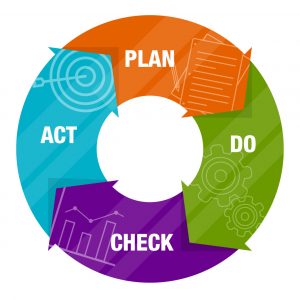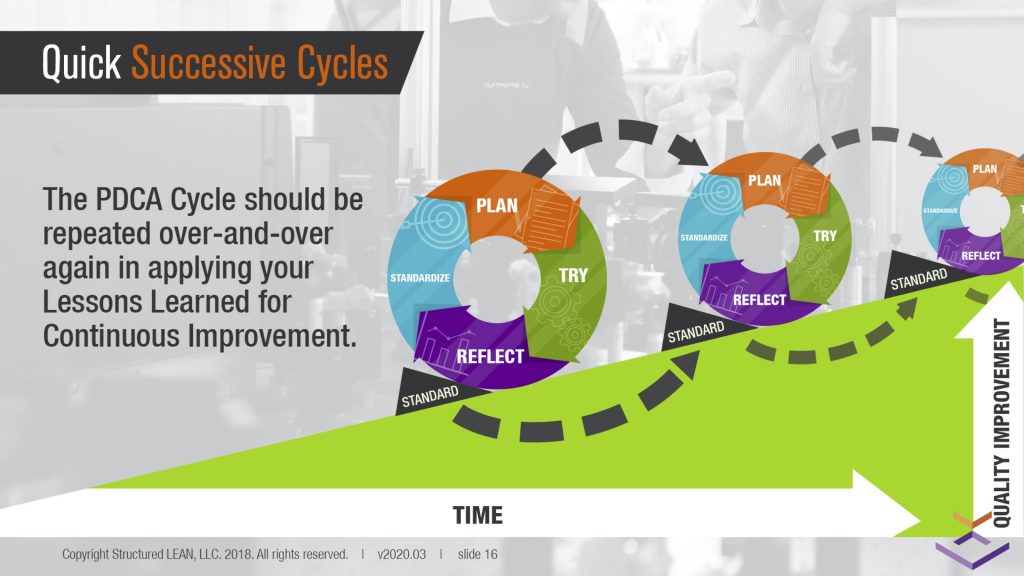If you’re unfamiliar or need a refresher with the basic concepts of PDCA, or Toyota’s iteration of the PDCA Cycle, we’ve provided a link to our resources:
- Learn more about the Traditional PDCA Explanation, from Wikipedia.
- Learn more about Toyota’s Iteration of the PDCA Cycle Training. [1]
From this continuous improvement and problem-solving method, we want to highlight two (2) important elements:
1. Within the Check Phase of the PDCA Cycle, it is critical to do the Reflection. By this, we mean assessing the positives outcomes and negatives outcomes, as well as identifying the lessons learned from your Plan and Do Phases, so you can make the necessary adjustments going forward.
Check is the Reflection of Positives (+) and Negatives (-), with Identified Lessons Learned
Also keep in mind that it is imperative to do the Reflection in shorter intervals. This also applies to any types of reviews [2] and follow-up [3] sessions, so the necessary adjustments can be made more quickly.
2. Because the PDCA Cycle is represented as a circle, this means there is no end. Therefore, the best application is to repeat the PDCA method over-and-over again in very quick successive cycles.
The end result will apply further knowledge and understanding, all of which has been gained by your experiences and applying the lessons learned from the Reflection Phase. As a result, the more cycles you apply to this end, the better the overall result!
References, and Links to Further Explanations
- The PDCA Cycle is one of the Primary Elements of Our Paradigms: Application of the PDCA Cycle. Learn more about Toyota’s Iteration of the PDCA Cycle Training.
- Reviews are part of the Management System, which is a Core Element of Our Balanced Approach for Implementation Training. Also learn more about the LEAN Management System within our A3 Methodology, and Thinking Training.
- Follow-up is one of Our Fundamentals of LEAN we have Defined: Follow-up.
Insight from a Master Sensei
When you are applying PDCA with the Core Team, make sure you do it after each step with focus on the “Check” and “Act” Phase. Ask each Core Team member to write-down and explain what is working, and WHY? And what is not working, and WHY? Then identify what we will do for those things that are not working, and WHY we will do them (this could also include multiple options or scenarios). Followed by the lessons they have learned from their efforts thus far.
Do this collectively as a Core Team. First, write it on a large sheet of paper (i.e., on a flipchart) or in the Microsoft Excel PDCA Worksheet [Template]. Second, talk with each other so everyone understands what the other person observed, and WHY? What is important is to have these discussions in order for every one of the Core Team members to clearly understand WHY something is or is not working. Only then can all of them start to see and understand it together in the same way.
Of course, this does not always result in complete agreement and/or in determining what the necessary next steps are. But based upon acknowledgement of the other Core Team member’s perspective and with a common understanding, it is easier to build consensus on what needs to happen next.
The end result will also bring the Core Team closer together with each other, as this process creates Mutual Respect and Trust. Core Team members also start to see that they are interdependent with one another, which contributes to stronger team work and comradery.
References, and Links to Further Explanations
- Download the Microsoft Excel PDCA Worksheet [Template] file HERE.


